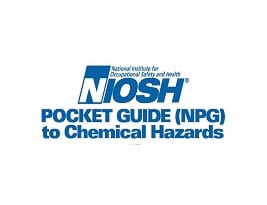Glutaraldehyde

Overview
CAS No. 111-30-8
Glutaraldehyde, C5H8O2 or OCH(CH₂)₃CHO, is a transparent oily, liquid with a pungent odor. Exposure to glutaraldehyde may cause the following symptoms: throat and lung irritation, asthma and difficulty breathing, dermatitis, nasal irritation, sneezing, wheezing, burning eyes, and conjunctivitis. Workers may be harmed from exposure to glutaraldehyde. Workers can be exposed to glutaraldehyde through inhalation or skin contact. The level of exposure depends upon the dose, duration, and work being done.
Glutaraldehyde is used for a number of applications:
- Disinfectant for surgical instruments that cannot be heat sterilized
- A cross-linking and tanning agent
- A biocide in metalworking fluids and in oil and gas pipelines
- An antimicrobial in water-treatment systems
- A slimicide in paper manufacturing
- A preservative in cosmetics
- A disinfectant in animal housing
- A tissue fixative in histology and pathology labs
- A hardening agent in the development of X-rays
- In embalming solutions
- In the preparation of grafts and bioprostheses
- In various clinical applications
NIOSH recommends that employers use Hierarchy of Controls to prevent injuries. If you work in an industry that uses glutaraldehyde, please read chemical labels and the accompanying Safety Data Sheet for hazard information. Visit NIOSH’s page on Managing Chemical Safety in the Workplace to learn more about controlling chemical workplace exposures.
The following resources provide information about occupational exposure to glutaraldehyde. Useful search terms for glutaraldehyde include “glutaric dialdehyde,” and “1,5-pentanedial.”
NIOSH Chemical Resources
Related NIOSH Resources
- NIOSHTIC-2 search results on Glutaraldehyde A searchable database of worker safety and health publications, documents, grant reports, and journal articles supported in whole or in part by NIOSH.
- Aldehydes, screening (No. 2539) NIOSH Manual of Analytical Methods (NMAM)
Selected Publications
- NIOSH Skin Notation Profiles: Glutaraldehyde DHHS (NIOSH) Publication No. 2011-149 (2011)
- NIOSH Glutaraldehyde: Occupational Hazards in Hospitals DHHS (NIOSH) Publication No. 2001-115. Provides information about the adverse health effects of glutaraldehyde, describes how hospital workers can be exposed to glutaraldehyde, and identifies control methods and work practices to prevent or reduce exposure. En Español
- NIOSH Current Intelligence Bulletin 55: Carcinogenicity of Acetaldehyde and Malonaldehyde, and Mutagenicity of Related Low-Molecular-Weight Aldehydes DHHS (NIOSH) Publication No. 91-112
Information about the potential carcinogenicity and mutagenicity of acetaldehyde and malonaldehyde, the chemical reactivity and mutagenicity of nine related aldehydes, and includes guidelines for minimizing can be exposed to glutaraldehyde, and identifies control methods and work practices to prevent or reduce exposure. - NIOSH Current Intelligence Bulletin 55: Carcinogenicity of Acetaldehyde and Malonaldehyde, and Mutagenicity of Related Low-Molecular-Weight Aldehydes DHHS (NIOSH) Publication No. 91-112
Information about the potential carcinogenicity and mutagenicity of acetaldehyde and malonaldehyde, the chemical reactivity and mutagenicity of nine related aldehydes, and includes guidelines for minimizing occupational exposures. - NIOSH Registry of Toxic Effects of Chemical Substances (RTECS): Glutaraldehyde Includes detailed information about toxic health effects and official exposure recommendations and standards for glutaraldehyde.
Related Resources
- Agency for Toxic Substances & Disease Registry (ASTDR): Glutaraldehyde
- ASTDR Toxciological Profile for Glutaraldehyde
- ASTDR ToxGuide: Glutaraldehydepdf icon
- FDA-Cleared Sterilants and High Level Disinfectantsexternal icon
- EPA Chemistry Dashboard: Glutaraldeydeexternal icon
- EPA: Reducing Ethylene Oxide and Glutaraldehyde Usepdf iconexternal icon
- Occupational Safety and Health Administration (OSHA) Best Practices for the Safe Use of Glutaraldehyde in Health Careexternal icon
- OSHA Hospital eTool: Glutaraldehydeexternal icon
- OSHA Hazard Communicationexternal icon
- New Jersey Hazardous Substance Fact Sheets: Glutaraldehydeexternal icon
International Resources
- European Chemicals Agency (ECHA): Glutaraldehydeexternal icon
- INCHEM-International Chemical Safety Data Card: Glutaraldehydeexternal icon
- Gestis Substance Databaseexternal icon
- OECD Global Portal to Information on Chemical Substancesexternal icon
- Organization for Economic Cooperation and Development (OECD) Screening Information Data Sets (SIDS): Glutaraldehydeexternal icon
- United Kingdom Health and Safety Executive Research Report (RR445): An Evaluation of Chemical Disinfecting Agents Used in Endoscopy Suites in the National Health Serviceexternal icon



